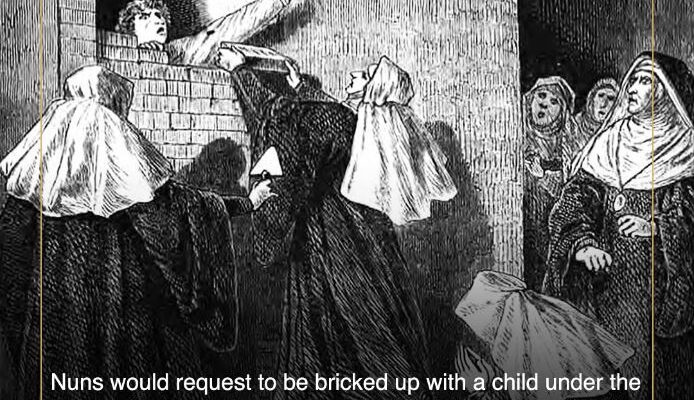Immurement, or the complete enclosure of a human being into a small space with no escape, was historically a common form of punishment across cultures throughout history. Indeed, history is full of terrifying tales of people who were bricked up or buried alive. Enclosing a person into a tiny box was considered one of the slowest forms of torture. However, some immurements were a deliberate personal choice, particularly among the devout of several religions, such as priests, monks, and nuns.
Trapping someone in a tight space was also one of the forms of torture used on women in particular. These immurements might last weeks, months, years, or until death. Some among the immured were sacrificial; some were unwitting victims. Certainly, in horrific stories of historical immurement, anyone even slightly claustrophobic would have struggled immensely and, as time passed and food and energy diminished, immurement must have seemed like a particularly harsh hell. If you want to know what it was like to suffocate slowly in an enclosed space, read on to get a taste of what it was like to be immured and left for dead.
-
Immurement Did Not Necessarily Mean Death – Unless They Forgot About Leaving You There
Photo: Antoine Wiertz / Wikimedia Commons / Public Domain
Many cases involving immurement were doled out to intentionally serve as very slow death penalties. However, immurement could also be a temporary condition which was used in one of two ways: as a form of punishment or by choice for a given length of time. The medieval Christian church used temporary immurement as a method to punish sinners, particularly those who committed sins of the flesh. Such individuals were locked away deep in a monastery or bricked up inside of rooms with a tiny opening for food and water for months or even years.
Centuries later, this type of immurement was still being used, but as a form of punishment. A good example comes from the unfortunate end of James Hepburn, third husband of Mary, Queen of Scots, who was accused of treason. After fleeing Scotland, he was apprehended in Denmark where he was imprisoned beneath Dragsholm Castle. He was put in a hole that was not large enough for him to stand in and subsisted off of food scraps in total darkness.
Danish authorities more or less forgot about Hepburn, and he remained in his hole for five years. When he was finally found, he acted like a feral animal. Hepburn did not use language, but instead only grunted and paced back and forth. He died shortly after.
Some cases of immurement had willing participants. Christian monks and nuns participated in immurement as a spiritual experience. They would choose the method, location, and length of time involved.
-
The Perfect Punishment For Lustful Vestal Virgins
Photo: Wellcome Images / Wikimedia Commons / CC BY 4.0
Ancient Roman religion was taken seriously by its leaders, practitioners, and even the secular government. As with most societies, there was also an ongoing concern over the chastity of women and how a woman’s natural lust was overwhelming and thus, had to be controlled. Vestal Virgins, or female temple priestesses of the goddess Vesta, were held to a particularly high standard of conduct. All took a solemn vow of chastity.
However, the priestesses were human and sometimes faltered. This was not a problem unless their lustful activities were discovered. On such occasions, a guilty priestess received capital punishment. This most often took the form of permanent immurement.
The Vestal Virgin would be stripped, beaten, dressed in the clothing of a corpse, and then placed in a catacomb or cave. Typically, she would be locked or bricked away with a small supply of food, water, and candles or lamps. When the supplies ran out, the Vestal Virgin would die a slow agonizing death.
-
Holy Women Liked Being Bricked Up With Little Boys Or Girls
Photo: Vinzenz Katzler / Wikimedia Commons / Public Domain
These immurements were pitched as a type of religious ritual, but they were more a case of “misery loves company.” An adult holy woman, such as Julian of Norwich, would sometimes request to be bricked in for a time (decades were not unusual) with a young child under the age of 10. Such children could be orphans, but often were “gifts” from their parents to the Church. The idea was that the child would serve as a symbol of innocence and purity as well as a companion to the willingly immured.
The nun and her “companion” would receive food through a small slit in the bricked up wall, but they would never, ever go outside the enclosed chamber.
-
Clerics Who Molested Boys Were Starved To Death In A Suspended Coffin
Photo: Johann Amos Comenius / Wikimedia Commons / Public Domain
In 1409, four Christian clerics in Augsburg, Bavaria, were found guilty of pederasty, or sexual conduct with young boys. Pederasty was not only considered immoral but also illegal.
The church in Augsburg locked the guilty men into wooden coffins, suspended them with ropes from high inside a tower, and left them to starve. They were then buried under the gallows.
-
Bodies Trapped In A Wall For Entertainment Purposes
Jazzar Pasha was a notorious 18th-century governor of Lebanon and Palestine. He was known for committing unspeakable cruelties to anyone who angered him.
At some point during his rule, he decided to build a new wall around the city of Beirut. And not just any wall – he wanted a structure that was strong, decorative, and entertaining. To that end, he captured a great many Greek Christians and had them essentially built into the wall.
-
King Richard II Of England Was Bricked Up
Photo: Anonymous / Wikimedia Commons / Public Domain
King Richard II of England ruled during the age in which Geoffrey Chaucer wrote his famous Canterbury Tales. It was a time of chivalry and Richard’s court was considered one of beauty and fashion. He was so interested in beauty, art, and culture that he lost track of political situations in his country.
Richard was deposed by a powerful rival. Having lost his crown, he was sent off to a castle where he presumably starved to death. Apparently, his murderers felt immurement was the best method to rid themselves of the former king since starvation would not show any marks or damage to the body.
-
Slaves And Family Members Were Sacrificially Immured
Photo: Hajor / Wikimedia Commons / CC BY-SA 3.0
The burial of a great Mongol Khan included the ritual killings of more than 100 members of his family, followed by his interment and the immurement of several favorite slaves.
He kindly remembered to request that the enslaved people be buried with several vessels of drink.
-
People Were Immured Into Building Foundations As A Good Luck Charm
When you’ve created something you’re proud of, you want to make sure it has the good luck to last forever. Such was the thinking of those who immured people – including children – in the foundations of a building. Especially under the cornerstone. It was a good luck charm sort of thing.
There was a Serbian tradition where a building project may not progress until the wife of one of the owners of the new building was immured into the foundation. The Magyars tell a similar tale of the building of the city of Deva, in which the compassion of the landowning spirit was derived by sacrificing the wife of one of the men who built the structure.
-
Writers Have Used Fictional Immurement To Enhance Stories
Photo: Byam Shaw / Wikimedia Commons / Public Domain
It’s well known that the human mind and creativity are boundless, so it’s no surprise that writers have used fictional examples of immurement to make their stories more exciting and frightening. The Ancient Greek playwright Sophocles is one of the first to use immurement in fiction. His heroine, Antigone, and her lover are imprisoned in a cave with the opening bricked shut. They eventually killed themselves, so their immurement was tragic but brief.
Dante certainly could not resist using immurement in his Divine Comedy. In Inferno’s ninth circle, the father of the Italian language has one of his greatest enemies and his two sons immured in a tower. British Romantic author Walter Scott delights in the immurement of an unchaste nun in his poem, “Marmion.” He writes, “And now the blind old abbot rose, To speak the chapter’s doom. On those the wall was to enclose, Alive, within the tomb.”
Edgar Allan Poe relies on immurement several times in his work, including the immurement of a protagonist’s enemy beneath the floor of a palazzo. In Poe’s “The Black Cat,” the narrator’s pet cat accidentally suffers immurement but is discovered and rescued. The cat’s rescue leads to the discovery of the body of the narrator’s wife since the cat was walled in with it after the murder.
-
Infants Were Abandoned And Immured
In some cases, immurement was the cause of death for infants. Bricking up or enclosing a wall or entrance wasn’t even necessary since little babies are unable to attempt escape. But why would anyone immure a newborn? Some answers include: poverty, fear, and shame.
Very poor families could not afford another mouth to feed, so infants were left wherever they would not be found. In ancient Rome, for example, it was not terribly frowned upon to kill babies as a form of birth control, since they were not considered to be completely human. Other infants might be killed because their mothers – sex workers or victims of rape – were ashamed of them.
Whatever the reason, babies were abandoned in catacombs, cloisters, cisterns, and cells. They were left to die, their only crime: existence.
-
Young Maidens Were Lowered Into Cisterns As A Human Sacrifice
Photo: Diego Delso / Wikimedia Commons / CC BY-SA 4.0
The Festival of the Sun is the most important religious celebration in Ancient Inca culture. It was a major event during ancient times that lasted for nine days and was filled with colorful dances and processions as well as animal sacrifices to thank the gods for a good harvest. Music was played and the people shared food.
Following the arrival of the Catholic Spaniards in the 16th century, the festival was banned for many years. While the Spaniards were determined to convert the Inca people to Catholicism by whatever means necessary, perhaps one of their reasons for banning the festival was the tradition of human sacrifice by immurement. After performing certain ceremonial duties, a number of young maidens, around 12 years of age, were lowered into a waterless cistern and sealed within it.











